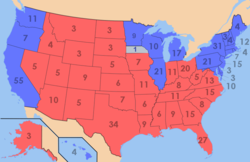User:VisusLinea/sandbox
Recognizing MAUP in Research.[edit]
Ilya Rosenfeld | UMBC
From the start, “The Big Sort” alleges a paradox. How is it possible that despite an apparent formation of local voter majorities which is winning by landslides, the 2004 presidential election was nearly too close to call? From there, there follows a descriptive study about a number of social and economic dynamics contributing to the redistribution and remapping of political landscape which results the current state of political “polarization” which is also apparent to the authors. This change is what they refer to as “the big sort” fueled in part by physical and economic mobility and population migration - all resulting in the current state the political geography.
The paper presents evidence to support the claim that the “big sort” is in fact occurring. Using various statistics aggregated by county, the authors show how voting patterns changed over the past several decades. While no falsifiable claims about causality are being made (in fact, the paper contains no hypothesis at all), authors also “hind-cast” certain socio–economic indicators of these changes such as geographic redistribution of income and educated population, religious affiliation, immigrant population and infusion, etc. At one point, the authors conclude that there indeed exist “two America’s separated by county lines” – the polarization is that profound.
At a purely deceptive level, the discussion about migration patterns resulting in current political landscape makes sense. However, there are a number of problems both with the evidence and conclusions offered by the authors:
- The alleged paradox (or the stuff of “cognitive dissonance”) is not a paradox at all. The overall outcome of a presidential election is essentially an aggregate value at the scale of the entire country; local spatial heterogeneity should not be expected to be somehow representative of the national outcome. In fact, Obama won by a landslide in 2008 while much migration couldn’t have occurred since 2004.
- All of the quantitative evidence for the “the big sort” is offered is as county-level statistics. A number of processes are described by county whether the arbitrary county areal unit is relevant to the process or not. For instance, what relevance does “county” unit does have in the elections process and outcomes? It is possible to devise areal units that more meaningful in the context of political processes and elections: congressional districts for instance. Similarly, migration patterns could be more fine-grained than be represented at a county aggregate level.
- Quantitatively, all of the evidence presented in the paper is suspect because it is presented at a single level of aggregation – again, by county. If a different unit is elected, the statistics will be different event if the general trends and dynamics remain generally consistent.
- The gist of the paper is that there is “polarization”, “division” and “homogenization” of the political landscape - all readily apparent in light of presented evidence. While there is likely clustering, and perhaps increased clustering of like-minded voters, all the aforementioned characterizations entirely and necessarily depend on the selection of the areal unit. The smaller and more regular the units get, the more spatial heterogeneity becomes apparent thereby dampening and perhaps entirety undoing the central claims of the paper. In fact, it’s possible to exacerbate these divisions simply be swapping county units for states (2004 Election Results, U Michigan):
-
Presidential electoral votes by state.
-
Presidential popular votes by county.
-
Testing!



